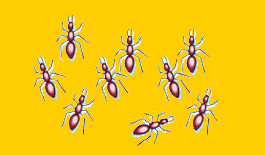|
Locating Information 3
.gif)
Non-fiction (information) books have lots of different sections that help us find and understand the information weíre looking for.A Glossary is always found at the back of the book but before the index pages. A glossary is like a mini-dictionary. It will give us the meaning of new and difficult words that we might read about in the book. The words in a glossary are arranged in alphabetical order. Look at this Glossary from a book on Ants.

Glossary abdomen- the rear section of an antís body
antenna- the feeler on an antís head , used to detect odors, flavours and sounds
aphid- a tiny insect that eats the sap of plant roots, leaves and flowers
callow- a newly emerged ant, not entirely hardened or fully coloured
cocoon- a white covering spun by some ant pupae for protection
colony- an organized group of ants living together and sharing work duties
compound eyes- large eyes made of 6 to 1000 tiny lenses
crop- the antís ďcommunityĒ stomach. Ants share the food in this stomach with other ants in the colony
egg- the first stage in metamorphosis. Ant eggs are sticky, white and smaller than a pinhead
gaster- the rear section of an antís abdomen
hibernate- to spend the winter in an inactive state during which all the body functions slow down
larva- the second stage in metamorphosis. Ant larvae are white, legless grubs
mandibles- the two jaws on either side of the antís mouth, used for digging, carrying and fighting
maxillae- two smaller jaws used for chewing food
metamorphosis- the life cycle of an ant, in which the insect goes through four complete changes in form: egg, larva, pupa and adult
ocelli- small, simple eyes found on the heads of some ant species
pupa- the third stage in metamorphosis. Some ant pupae spin a cocoon around themselves in this stage
queen- the fertile female ant in a colony, capable of laying all the colonyís eggs
reproductive ants- ants able to mate and produce young. Only queens and males are capable of reproduction
soldier- a large, strong-jawed type of worker ant, especially suited for fighting
thorax- the middle section of an antís body, between the head and abdomen
worker- a small female ant that does all the work of the colony

1) What time of year do ants hibernate?
[,
spring,
winter,
summer]
2) What are mandibles?
[,
an antís nest,
an antís legs,
an antís jaws]
3) What is the name of the tiny insect that eats the sap of plant roots, leaves and flowers?
[,
aphid,
ocelli,
thorax]
4) In which part of a book would I find the Glossary page?
[,
beginning,
end,
middle]
5) What is a soldier ant particularly suited to?
[,
fighting,
eating,
building]
6) What kind of order is a Glossary arranged in?
[,
there is no particular order,
by page number,
by alphabetical order]
7) What is the name for the third stage in metamorphosis?
[,
larva,
egg,
pupa]
|



